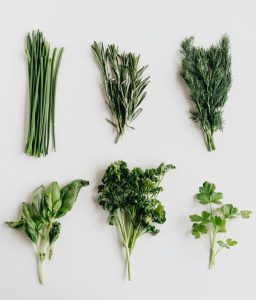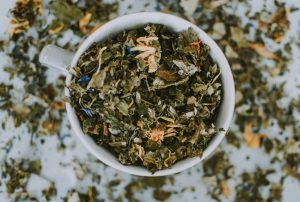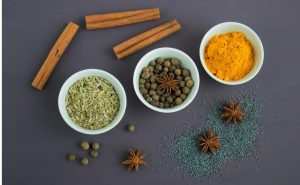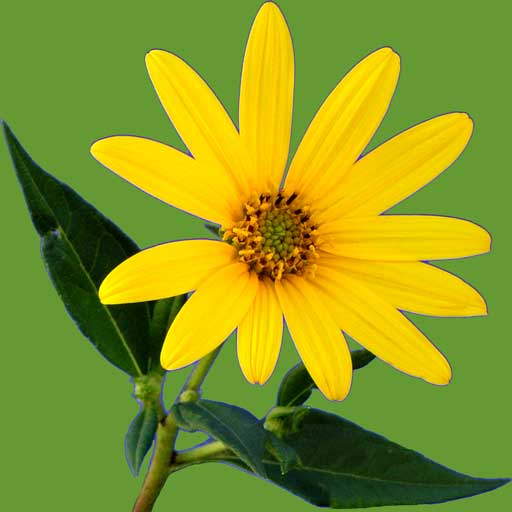Understanding the Different Types of Herbs
Herbs are incredibly versatile plants that have been used for thousands of years for their culinary, medicinal, and aromatic properties. Isabell’s comprehensive guide, “How Can I Use Herbs In My Daily Life?”, delves into the myriad uses of over 500 herbs, spices, and edible plants. Here, we’ll explore the different types of herbs and their unique benefits.
Culinary Herbs
 Culinary herbs are essential in the kitchen, adding flavour, aroma, colour and nutrition to our meals. These herbs can transform ordinary dishes into gourmet experiences. Culinary herbs typically come from the leafy, green parts of plants, and they are used either fresh or dried to enhance the taste of food. Herbs can dress up an economical dish, enrich a meal to make a tastebud treat, a meal fit for a King.
Culinary herbs are essential in the kitchen, adding flavour, aroma, colour and nutrition to our meals. These herbs can transform ordinary dishes into gourmet experiences. Culinary herbs typically come from the leafy, green parts of plants, and they are used either fresh or dried to enhance the taste of food. Herbs can dress up an economical dish, enrich a meal to make a tastebud treat, a meal fit for a King.
Here are some popular culinary herbs and their uses:
1. Basil
Basil is a versatile herb used in a variety of cuisines, particularly in Italian dishes like pesto and pasta. Its sweet, aromatic flavour, makes it a staple in many kitchens.
2. Rosemary
Known for its strong, pine-like aroma, rosemary is perfect for seasoning meats and vegetables. Rosemary is often used to enhance the flavour of roasted dishes and soups.
3. Thyme
Thyme adds a subtle earthiness to dishes and is often used in soups, stews, and roasted meats. Its small, aromatic leaves pack a powerful punch of flavor.
4. Mint
Mint is refreshing and versatile, used in both sweet and savoury dishes. It’s commonly added to desserts, beverages, and salads for a burst of cool flavor.
In addition to their culinary uses, many herbs also offer health benefits. They can be rich in vitamins, minerals, and antioxidants, and some have been used traditionally for their medicinal properties.
Medicinal Herbs
 Medicinal herbs have been used for centuries to treat various ailments and promote overall health. These herbs contain active compounds such as alkaloids, tannins, flavonoids, and essential oils, which have been traditionally used in herbal medicine practices across different cultures. Medicinal herbs can be consumed in various forms, including teas, tinctures, capsules, poultices, and essential oils. Herbs are very complex with many constituents and various actions, and Isabell provides extensive information on the healing properties of herbs, and how herbs support the innate healing process.
Medicinal herbs have been used for centuries to treat various ailments and promote overall health. These herbs contain active compounds such as alkaloids, tannins, flavonoids, and essential oils, which have been traditionally used in herbal medicine practices across different cultures. Medicinal herbs can be consumed in various forms, including teas, tinctures, capsules, poultices, and essential oils. Herbs are very complex with many constituents and various actions, and Isabell provides extensive information on the healing properties of herbs, and how herbs support the innate healing process.
Here are some key medicinal herbs:
1. Chamomile
Chamomile is renowned for its calming effects and is often used to alleviate anxiety and promote sleep. It is commonly used in teas to help with relaxation and digestion.
2. Echinacea
Known for its immune-boosting properties, echinacea is commonly used to prevent and treat colds and infections. It helps stimulate the body’s immune response.
3. Lavender
Lavender is not only aromatic but also has medicinal benefits. It is used to relieve stress, anxiety, and insomnia, and is also used in teas and baths for its soothing effects
4. Ginger
Ginger is a powerful herb with anti-inflammatory and digestive benefits. It is often used to relieve nausea, improve digestion, and reduce inflammation.
Medicinal herbs offer a natural approach to health and wellness, providing therapeutic benefits that can complement conventional medicine.
Aromatic Herbs
 Aromatic herbs are valued for their fragrant qualities, which can enhance the sensory experience of living spaces. These herbs are often used in cooking, medicine, and aromatherapy due to their distinctive scents and flavors. The aroma of these herbs comes from volatile compounds, primarily essential oils, which can be released when the herb is crushed, chopped, or heated. Isabell would often say that “the aroma of herbs delights the senses, which revitalises the body”.
Aromatic herbs are valued for their fragrant qualities, which can enhance the sensory experience of living spaces. These herbs are often used in cooking, medicine, and aromatherapy due to their distinctive scents and flavors. The aroma of these herbs comes from volatile compounds, primarily essential oils, which can be released when the herb is crushed, chopped, or heated. Isabell would often say that “the aroma of herbs delights the senses, which revitalises the body”.
Some popular aromatic herbs include:
1. Lemon Balm
Lemon balm has a fresh, lemony scent and is used to uplift the mood and relieve stress. It is often added to teas and used in aromatherapy.
2. Sage
Sage has a strong, earthy aroma and is used in cooking as well as in smudging rituals to purify spaces. Its distinctive scent can transform the atmosphere of a room.
3. Rosemary
Besides its culinary uses, rosemary is highly aromatic and used in potpourri and sachets to freshen up rooms and closets.
4. Peppermint
Peppermint’s invigorating scent is used in aromatherapy to enhance focus and energy. It is also used in teas and as a natural remedy for headaches.
Aromatherapy is the extraction of essential oils from aromatic herbs to promote physical and emotional well-being. Oils like lavender, eucalyptus, and rosemary are commonly used in diffusers, massage oils, and bath products.
Multifunctionality
One of the most exciting aspects of herbs is their multifunctionality. Many herbs can be classified as culinary, medicinal, and aromatic. For example, rosemary can be used to flavour a dish, soothe a headache, and freshen a room. In her book Isabell encourages us to explore these multiple uses, stating, “Herbs benefit our body in many ways… The wholeness and freshness of the herbs and food we eat is vital to human health”
Understanding the different types of herbs and their uses can significantly enhance your daily life, from improving your cooking to supporting your health and creating a pleasant living environment.
In her book Isabell provides research and practical ways of using plants. Not all chapters on culinary herbs have recipes, as it became apparent when Isabell was less than a quarter of the way through writing, that the book would be massive if it included all the recipes she wanted to share. Some chapters have anecdotal real-life experiences that people have shared with her, of healing and improved health through herbs. These she shares with you to encourage and inspire you to have optimum health, naturally.
Under culinary uses, Isabell has indicated plants useful as survival food. She believed that planting food for the future is important in an uncertain world. Start now to grow plants that have survival food potential.
Guidelines when starting on herbs for medicinal use
- Start slowly with herbal remedies to avoid potential side effects like diarrhoea or nausea.
- Herbs work gradually to restore bodily functions, not as instant cures.
- Some herbs can have side effects or cause allergic reactions in certain individuals.
- Herbs may interact with prescription medications, so inform both your doctor and alternative health practitioner about all treatments you’re taking.
- While generally safe when used properly, herbs can be powerful and should be used with caution.
Use Coupon Code: CB8ZJZ44 to get an extra 10% off any product, including specials – Get up to a total of 20% off. (Does not include postage) Discount expires 12th September 2024
wishing you health and well-being
Ricky Shipard

